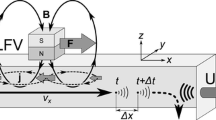Abstract
Velocity measurements inside metal melt flows are important for many laboratory and industrial applications in metallurgy but remain experimentally challenging. Only few techniques are viable for the measurement of mean flow velocities inside hot and aggressive materials. One of them is the previously studied electromagnetic contact-free Lorentz force velocimetry. However, the desire to resolve velocities spatially has not been satisfied so far. In the work presented here, spatial resolution is reached with a Lorentz force flow meter (LFF) by implementing a permanent magnet whose dimensions are significantly smaller than that of the flow under investigation. It is shown on a straight square duct flow that such a flow meter is capable of distinguishing obstacles in the flow and the resulting modified flow structures. The spatial resolution of the LFF is demonstrated to be at least on the order of 3 cm with a 1 cm magnet cube.






Similar content being viewed by others
References
Bruun H (1995) Hot-wire anemometry: principles and signal analysis. Oxford University Press, Oxford
Eckert S, Gerbeth G, Melnikov V (2003) Velocity measurements at high temperatures by ultrasound Doppler velocimetry using an acoustic wave guide. Exp Fluids 35:381–388
Feng CC, Deeds WE, Dodd CV (1975) Analysis of eddy-current flowmeters. J Appl Phys 46(7):2935–2940
Füßl R (2007) Interferenzoptische kraftsensoren für den lastbereich bis 0,1 Newton. Habilitation, Ilmenau University of Technology
Füßl R, Jäger G (2009) The influence of the force feed-in system on high-accuracy low force measurement. XIX IMEKO World Congress—Fundamental and Applied Metrology, Lisbon, Portugal
Heinicke C, Tympel S, Pulugundla G, Rahneberg I, Boeck T, Thess A (2012) Interaction of a small permanent magnet with a liquid metal duct flow. J Appl Phys 112:124914
Hofmann F (2003) Fundamental principles of electromagnetic flow measurement. Tech. rep., KROHNE Messtechnik GmbH & Co. KG
Jian D, Karcher C (2012) Electromagnetic flow measurements in liquid metals using time-of-flight Lorentz Force Velocimetry. Meas Sci Technol 23:074021
Kolesnikov Y, Karcher C, Thess A (2011) Lorentz force flowmeter for liquid aluminum: laboratory experiments and plant tests. Metall Mater Trans B 42(3):441–450
Lehde H, Lang W (1948) Device for measuring rate of fluid flow. Patent US 2,435,043
Lomas C (2011) Fundamentals of hot wire anemometry, reissue edn. Cambridge University Press, Cambridge
Minchenya V, Karcher C, Kolesnikov Y, Thess A (2009) Lorentz force flow meter in industrial application. Magnetohydrodynamics 45(3):459–465
Priede J, Buchenau D, Gerbeth G (2009) Force-free and contactless sensor for electromagnetic flowrate measurements. Magnetohydrodynamics 45(3):451–458
Priede J, Buchenau D, Gerbeth G (2011) Contactless electromagnetic phase-shift flowmeter for liquid metals. Meas Sci Technol 22(5):055402
Pulugundla G, Heinicke C, Karcher C, Thess A (2013) Lorentz force velocimetry with a small permanent magnet. Accepted for publication in Eur J Mech B Fluids. http://dx.doi.org/10.1016/j.euromechflu.2013.03.008
Rackers K, Thomas B (2 April 1995) Clogging in continuous casting nozzles. In: Proceedings of the 78th steelmaking conference, Nashville, TN, vol 78, pp 723–734
Raffel M, Willert C, Wereley S, Kompenhans J (2007) Particle image velocimetry: a practical guide. Experimental fluid mechanics. Springer, New York
Ricou R, Vives C (1982) Local velocity and mass transfer measurements in molten metals using an incorporated magnet probe. Int J Heat Mass Transf 25:1579–1588
Shercliff J (eds) (1962) The theory of electromagnetic flow measurement. Cambridge University Press, Cambridge
Stefani F, Gundrum T, Gerbeth G (2004) Contactless inductive flow tomography. Phys Rev E 70(5):056306
Stieglitz R (2007) Handbook on lead-bismuth eutectic alloy and lead properties, materials compatibility, thermal-hydraulics and technologies, chap. 11. Instrumentation. Nuclear Energy Agency (NEA)
Takeda Y (1987) Measurement of velocity profile of mercury flow by ultrasound Doppler shift method. Nucl Technol 79:120–124
Thess A, Votyakov E, Knaepen B, Zikanov O (2007) Theory of the Lorentz force flowmeter. New J Phys 9(8):299
Thess A, Votyakov E, Kolesnikov Y (2006) Lorentz force velocimetry. Phys Rev Lett 96(16):164501
Thomas B, Chaudhary R (2009) State of the art in electromagnetic flow control in continuous casting of steel slabs: Modeling and plant validation. In: 6th International conference on electromagnetic processing of materials (EPM). Dresden
Timmel K, Eckert S, Gerbeth G (2011) Experimental investigation of the flow in a continuous-casting mold under the influence of a transverse, direct current magnetic field. Metall Mater Trans B 42:68–80
Wegfraß A, Diethold C, Werner M, Fröhlich T, Halbedel B, Hilbrunner F, Resagk C, Thess A (2012) A universal noncontact flowmeter for liquids. Appl Phys Lett 100:194103
Wegfraß A, Diethold C, Werner M, Resagk C, Fröhlich T, Halbedel B, Thess A (2012) Flow rate measurement of weakly conducting fluids using Lorentz Force Velocimetry. Meas Sci Technol 23:105307
Wiegand DE (1968) Summary of an analysis of the eddy-current flowmeter. IEEE Trans Nucl Sci 15(1):28–36
Wiegand DE, Michels C (1969) Performance tests on an eddy-current flowmeter. IEEE Trans Nucl Sci 16(1):192–195
Wondrak T, Galindo V, Gerbeth G, Gundrum T, Stefani F, Timmel K (2010) Contactless inductive flow tomography for a model of continuous steel casting. Meas Sci Technol 21:045402
Acknowledgments
The author gratefully acknowledges the helpful discussions with A. Thess and G. Pulugundla. The work has been financed by the German Science Foundation (Deutsche Forschungsgemeinschaft) in the framework of the Research Training Group (Graduiertenkolleg) “Lorentz Force Velocimetry and Lorentz Force Eddy Current Testing” (Grant GRK 1567/1).
Author information
Authors and Affiliations
Corresponding author
Rights and permissions
About this article
Cite this article
Heinicke, C. Spatially resolved measurements in a liquid metal flow with Lorentz force velocimetry. Exp Fluids 54, 1560 (2013). https://doi.org/10.1007/s00348-013-1560-0
Received:
Revised:
Accepted:
Published:
DOI: https://doi.org/10.1007/s00348-013-1560-0




